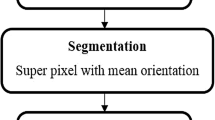Abstract
Automated segmentation of retinal vessels plays a pivotal role in early diagnosis of ophthalmic disorders. In this paper, a blood vessel segmentation algorithm using an enhanced fuzzy min-max neural network supervised classifier is proposed. The input to the network is an optimal 11-D feature vector which consists of spatial as well as frequency domain features extracted from each pixel of a fundus image. The essence of the method is its hyperbox classifier which performs online learning and gives binary output without any need of post-processing. The method is tested on publicly available databases DRIVE and STARE. The results are compared with the existing methods in the literature. The proposed method exhibits efficient performance and can be implemented in computer aided screening and diagnosis of retinal diseases. The method attains an average accuracy, sensitivity and specificity of 95.73%, 74.75% and 97.81% on DRIVE database and 95.51%, 74.65% and 97.11% on STARE database, respectively.




Similar content being viewed by others
References
Abramoff MD, Garvin MK, Sonka M (2010) Retinal imaging and image analysis. IEEE Rev Biomed Eng 3:169–208
Asghari MH, Jalali B (2015) Edge detection in digital images using dispersive phase stretch transform. International Journal of Biomedical Imaging 2015:1–7
Frangi AF, Niessen WJ, Vincken KL, Viergever MA (1998) Multiscale vessel enhancement filtering, Medical Image Computing and Computer Assisted Intervention MICCAI-98, pp 130–137
Franklin SW, Rajan SE (2014) Retinal vessel segmentation employing ann technique by gabor and moment invariants-based features. Appl Soft Comput 22:94–100
Fraz MM, Remagnino P, Hoppe A, Uyyanonvara B, Rudnicka AR, Owen CG, Barman SA (2012) An ensemble classification-based approach applied to retinal blood vessel segmentation. IEEE Trans Biomed Eng 59:2538–2548
Gabrys B, Bargiela A (2000) General fuzzy min-max neural network for clustering and classification. IEEE Trans Neural Netw 11:769–783
Gonzalez RC, Woods ASLERE (2010) Digital Image Processing Using MATLAB, 2nd edn. McGraw Hill Education, New York
Hoover AD, Kouznetsova V, Goldbaum M (2000) Locating blood vessels in retinal images by piecewise threshold probing of a matched filter response. IEEE Trans Med Imaging 19:203–210
International Diabetes Federation (2015). IDF diabetes atlas, 7th ed. ISBN: 978-2-930229-81-2
Kovesi P (1999) Image features from phase congruency. Videre: A J Comput Vis Res MIT Press 1:1–27
Lupascu C, Tegolo D, Trucco E (2010) Fabc: retinal vessel segmentation using adaboost. IEEE Trans Inf Technol Biomed 14:1267–1274
Marin D, Aquino A, Gegundez-Arias M, Bravo J (2011) A new supervised method for blood vessel segmentation in retinal images by using gray-level and moment invariants-based feature. IEEE Trans Med Imaging 30:146–158
Mohammed MF, Lim CP (2015) An enhanced fuzzy min—max neural network for pattern classification. IEEE Trans Neural Netw Learn Syst 26:417–429
Mookiah MR, Acharya U, Chua CK, Lim CM, Ng E, Laude A (2013) Computer-aided diagnosis of diabetic retinopathy: A review. Comput Biol Med 43:2136–2155
Niemeijer M, Staal J, Van-ginneken B, Loog M, Abramoff M (2004) Comparative study of retinal vessel segmentation methods on a new publicly available database. In: Fitzpatrick JM, Sonka M (eds) SPIE Medical Imaging. SPIE, vol 24, pp 648–656
Ricci E, Perfetti R (2007) Retinal blood vessel segmentation using line operators and support vector classification. IEEE Trans Med Imaging 26:1357–1365
Roychowdhury S, Koozekanani DD, Parhi KK (2015) Blood vessel segmentation of fundus images by major vessel extraction and subimage classification. IEEE J Biomed Health Inf 19:1118–1128
Simpson PK (1992) Fuzzy min-max neural networks-i classification. IEEE Trans Neural Netw 3:776–786
Sinthanayothin C, Boyce J, Cook H, Williamson T (1999) Automated localisation of the optic disc, fovea, and retinal blood vessels from digital colour fundus images. British J Ophthalmol 83:902–910
Soares J, Leandro J, Cesar R, Jelinek H, Cree M (2006) Retinal vessel segmentation using the 2-d gabor wavelet and supervised classification. IEEE Trans Med Imaging 25:1214–1222
Staal J, Abramoff MD, Niemeijer M, Viergever M, Van-Ginneken B (2004) Ridge-based vessel segmentation in color images of the retina. IEEE Trans Med Imaging 23:501–509
Vega R, Sanchez-Ante G, Falcon-Morales LE, Sossa H, Guevara E (2015) Retinal vessel extraction using lattice neural networks with dendritic processing. Comput Biol Med 58:20–30
Wang S, Yin Y, Cao G, Wei B, Zheng Y, Yang G (2015) Hierarchical retinal blood vessel segmentation based on feature and ensemble learning. Neurocomputing 149:708–717
You X, Peng Q, Yuan Y, Cheung YM, Lei J (2011) Segmentation of retinal blood vessels using the radial projection and semi-supervised approach. Pattern Recogn 44:2314–2324
Zhu C, Zou B, Zhao R, Cui J, Duan X, Chen Z, Liang Y (2017) Retinal vessel segmentation in colour fundus images using extreme learning machine. Comput Med Imaging Graph 55:68–77
Author information
Authors and Affiliations
Corresponding author
Ethics declarations
Conflict of interests
There is no conflict of interest declared by any of the authors.
Ethical Approval
The article does not contain any studies with human participants performed by any of the authors.
Additional information
Publisher’s note
Springer Nature remains neutral with regard to jurisdictional claims in published maps and institutional affiliations.
Rights and permissions
About this article
Cite this article
Biyani, R.S., Patre, B.M. & Kulkarni, U.V. Retinal vessel segmentation using enhanced fuzzy min-max neural network. Multimed Tools Appl 78, 35053–35073 (2019). https://doi.org/10.1007/s11042-019-08061-7
Received:
Revised:
Accepted:
Published:
Issue Date:
DOI: https://doi.org/10.1007/s11042-019-08061-7




